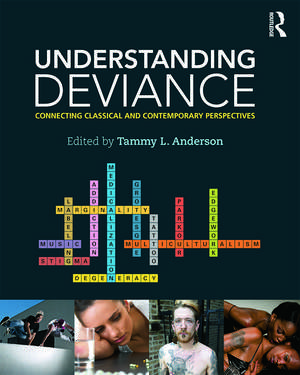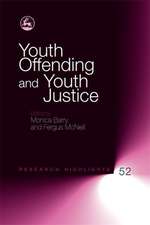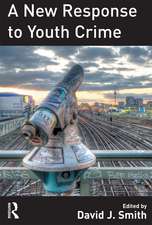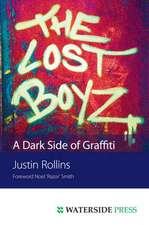Understanding Deviance: Connecting Classical and Contemporary Perspectives: Contemporary Sociological Perspectives
Autor Tammy L. Andersonen Limba Engleză Paperback – 28 ian 2014
First, in 12 separate sections, she presents a wide range of deviant behaviors, traits, and conditions including: underage drinking and drunk driving, doping in elite sports, gang behavior, community crime, juvenile delinquency, hate crime, prison violence and transgendered prisoners, mental illness, drug-using women and domestic violence, obesity, tattooing, sexual fetishes, prostitution, drug epidemics, viral pandemics, crime control strategies and racial inequality, gay neighborhoods, HIV and bugchasers, and (lastly) youth, multicultural identity and music scenes.
Second, her pairing of "classic" and "contemporary" viewpoints about deviance and social control not only "connects" important literatures of the past to today’s (student) readers, her "connections framework" also helps all of us see social life and social processes more clearly when alternative meanings are accorded to similar forms of deviant behavior. We also learn how to appreciate and interact with those who see things differently from ourselves. This may better equip us to reach common goals in an increasingly diverse and ever-changing world.
Third, a major teaching goal of Anderson’s anthology is to sharpen students’ critical thinking skills by forcing them to look at how a deviant behavior, trait or condition, can be viewed from opposing or alternative perspectives. By learning to see deviance from multiple perspectives, students will better understand their own and other’s behavior and experiences and be able to anticipate future trends. Balancing multiple perspectives may also assist students in their practical work in social service, criminal justice and other agencies and institutions that deal with populations considered "deviant" in one way or another.
| Toate formatele și edițiile | Preț | Express |
|---|---|---|
| Paperback (1) | 363.51 lei 6-8 săpt. | |
| Taylor & Francis – 28 ian 2014 | 363.51 lei 6-8 săpt. | |
| Hardback (1) | 1166.09 lei 6-8 săpt. | |
| Taylor & Francis – 5 feb 2014 | 1166.09 lei 6-8 săpt. |
Preț: 363.51 lei
Preț vechi: 460.58 lei
-21% Nou
Puncte Express: 545
Preț estimativ în valută:
69.56€ • 72.48$ • 57.59£
69.56€ • 72.48$ • 57.59£
Carte tipărită la comandă
Livrare economică 03-17 aprilie
Preluare comenzi: 021 569.72.76
Specificații
ISBN-13: 9780415642613
ISBN-10: 0415642612
Pagini: 600
Ilustrații: 12 black & white tables
Dimensiuni: 187 x 235 x 30 mm
Greutate: 1.02 kg
Ediția:1
Editura: Taylor & Francis
Colecția Routledge
Seria Contemporary Sociological Perspectives
Locul publicării:Oxford, United Kingdom
ISBN-10: 0415642612
Pagini: 600
Ilustrații: 12 black & white tables
Dimensiuni: 187 x 235 x 30 mm
Greutate: 1.02 kg
Ediția:1
Editura: Taylor & Francis
Colecția Routledge
Seria Contemporary Sociological Perspectives
Locul publicării:Oxford, United Kingdom
Public țintă
UndergraduateCuprins
Preface, Tammy L. Anderson / Part 1: Classic and Contemporary Approaches to Deviance: Section 1. Defining Deviance: Introduction, Tammy L. Anderson, 1. Rules for the Distinction of The Normal and the Pathological, Emile Durkheim / 2. Notes on the Sociology of Deviance, Kai T. Erikson / 3. Definitions of Deviance and Deviance and the Responses of Others from Outsiders, Howard S. Becker / 4. Defining Deviance Down, Daniel Moynihan / 5. Connections: Definitions of Deviance and the Case of Underage Drinking and Drunk Driving, Tammy L. Anderson, Critical Thinking Questions / Section 2. Functionalism, Anomie, General Strain Theory: Introduction, Tammy L. Anderson. / 6. Social Structure and Anomie, Robert Merton / 7. Homeboys, New Jacks, and Anomie, John M. Hagedorn / 8. A General Strain Theory of Community Differences in Crime Rates, Robert Agnew / 9. Connections: Understanding Doping in Elite Sports through Anomie and General Strain Perspectives, Tammy L. Anderson, Critical Thinking Questions / Section 3. Social Disorganization and Collective Efficacy: Introduction, Tammy L. Anderson / 10. Introduction and Growth of Chicago and Differentiation of Local Areas from Juvenile Delinquency and Urban Areas, Clifford R. Shaw and Henry D. McKay / 11. Collective Efficacy Theory: Lessons Learned and Directions for Future Inquiry, Robert J. Sampson / 12. The Urban Ecology of Bias Crime: A Study of Disorganized and Defended Neighborhoods, Ryken Grattet / 13. Connections: The Prison Community from a Social Disorganization and Collective Efficacy Perspective, Lori Sexton, Critical Thinking Questions / Section 4. Social Pathology, Degeneracy and Medicalization: Introduction, Tammy L. Anderson / 14. Social Pathology: A Systematic Approach to the Theory of Sociopathic Behavior, Edwin Lemert / 15. Whatever Happened to Social Pathology? Conceptual Fashions and the Sociology of Deviance, Joel Best / 16. The Shifting Engines of Medicalization, Peter Conrad / 17. Connections: Mental Illness as Degeneracy and Disease, Victor Perez, Critical Thinking Questions / Section 5. Labeling, Resistance, and Edgework: Introduction, Tammy L. Anderson / 18. Beyond Mead: The Societal Reaction to Deviance, Edwin W. Lemert / 19. Edgework: A Social Psychological Analysis of Voluntary Risk Taking, Stephen Lyng / 20. Resistance as Edgework in Violent Intimate Relationships of Drug-Involved Women, Rajah Valli / 21. Connections: Labeling, Resistance and Edgework through Parkour, John J. Brent, Critical Thinking Questions / Section 6. Stigma, Carnival, and the Grotesque Body: Introduction, Tammy L. Anderson / 22. Stigma and Social Identity from Stigma, Erving Goffman / 23. Why do People get Tattoos?, Miliann Kang and Katherine Jones / 24. Big Handsome Men, Bears and Others: Virtual Constructions of 'Fat Male Embodiment', Lee F. Monaghan / 25. Connections: Explaining Body Deviance with Stigma and Carnival of the Grotesque, David Lane, Critical Thinking Questions / Section 7. Deviant Careers, Identity and Lifecourse Criminology: Introduction, Tammy L. Anderson / 26. Kinds of Deviance: A Sequential Model from Outsiders, Howard S. Becker / 27. Crime and Deviance in the Lifecourse, Robert Sampson and John Laub / 28. Weighing the Consequences of a Deviant Career: Factors Leading to an Exit From Prostitution, Sharon Oselin / 29. Connections: Understanding Street Prostitution from Deviant Career and Life-Course Criminology Perspectives, Emily Bonistall and Kevin Ralston, Critical Thinking Questions / Section 8. Moral Panics and Risk Society: Introduction, Tammy L. Anderson / 30. Deviance and Moral Panics from Folk Devils and Moral Panics, Stanley Cohen / 31. Moral Panics: Culture, Politics, and Social Construction, Erich Goode and Nachman Ben-Yehuda / 32. Moral panic versus the risk society: the implications of the changing sites of social anxiety, Sheldon Ungar / 33. Connections: [A]moral Panics and Risk in Contemporary Drug and Viral Pandemic Claims, Philip R. Kavanaugh and R.J. Maratea, Critical Thinking Questions / Section 9. Critical Criminology, Culture of Control, Mass Incarceration: Introduction, Tammy L. Anderson / 34. Child Saving Movement in Illinois from The Child Savers: The Invention of Delinquency, Anthony M. Platt / 35. The Hyper-Criminalization of Black and Latino Male Youth in the Era of Mass Incarceration, Victor Rios / 36. Reforming Education Through Crime from Governing through Crime, Jonathan Simon / 37. Connections: The Social Control of Youth across Institutional Spheres, Aaron Kupchik, Critical Thinking Questions / Part 2. Emergent Possibilities and the Future of Deviance: Section 10. Queer Theory, Communities and Citizenship: Introduction, Tammy L. Anderson / 38. Coming Out all Over: Deviants and the Politics of Social Problems, John I. Kitsuse / 39. There goes the Gayborhood, Amin Ghaziani / 40. Queer Presences and Absences: Citizenship, Community, diversity–or Death, Yvette Taylor / 41. Connections: HIV and Bug Chasers across Queer Collectives, Holly Swan and Laura Monico, Critical Thinking Questions / Section 11. Critical Race Theory, Multiculturalism, and Identity: Introduction, Tammy L. Anderson / 42. Deviance as Resistance: A new Research Agenda for the Study of Black Politics, Cathy J. Cohen / 43. The Battle of Los Angeles: The Cultural Politics of Chicana/o Music in the Greater Eastside, Victor Hugo Viesca / 44. I was aggressive for the streets, pretty for the pictures: Gender, difference and the inner-city girl, Nikki Jones / 45. Connections: Marginality, Identity and Music Scenes, Tammy L. Anderson, Critical Thinking Questions / Section 12. Biomedicalization, BioPower and Biocitizens: Introduction, Tammy L. Anderson / 46. The Medicalization of Unhappiness, Ronald W. Dworkin / 47. Civilizing Technologies and the Control of Deviance, Scott Vrecko / 48. Connections: BioMedicalization of Drug Addiction and the Reproduction of Inequality, Tammy L. Anderson and Philip Kavanaugh, Critical Thinking Questions
Notă biografică
Tammy L. Anderson is a Professor of Sociology and Criminal Justice at the University of Delaware. Her recent books Rave Culture: The Alteration and Decline of a Philadelphia Music Scene (Temple University Press), Sex, Drugs, and Death (Routledge), and Neither Villain nor Victim: Empowerment and Agency among Women Substance Abusers (Rutgers University Press), along with her many peer review papers on substance abuse, crime, and music scenes, showcase her range of scholarship in the area of deviance, culture, and social control.
Recenzii
"I applaud the editor for her attention to detail in putting together these important topics. This book provides studies that are both theoretically relevant and empirically interesting. The editor focused attention on classical research and then outlined the evolution of deviance studies. Students of sociology, criminology, and social psychology will greatly benefit from her work."
-Rebecca Trammell, Criminal Justice and Criminology, Metropolitan State University of Denver
"Understanding Deviance brings the study of deviance up to date by revealing the links between the field’s classic works and contemporary developments in sociology (including biomedicalization, edgework, the carnival of the grotesque, risk society, queer theory, and critical race theory) and criminology (including general strain theory, lifecourse criminology, and mass incarceration). Both instructors and students should appreciate this unique approach to the study of deviance."
-Joel Best, Sociology and Criminal Justice, University of Delaware
"Understanding Deviance: Connecting Classical and Contemporary Perspectives offers a stimulating yet serious exploration of deviance. The pairings of classical essays with cutting-edge research on contemporary, provocative issues exemplify the role of context in defining deviance and ways in which perspectives change or remain the same, while the Connections essays extend the theoretical and practical applications to facilitate higher-level thinking and critical analysis."
-Sarah M. Smith, Sociology and Criminal Justice, Elmhurst College
"Anderson has assembled an outstanding collection of readings that, though written from a range of perspectives, examines many of the central and critical issues in the sociology of deviance. In addition to providing the reader with a solid grounding in classic works across several theoretical traditions, Understanding Deviance connects these core foundational works to cutting-edge scholarship in sociology, criminology, and penology. Although there is no shortage of deviance texts on the market, Understanding Deviance deserves the careful consideration of those seeking an imaginatively curated collection of essays spanning multiple disciplines and schools of thought."
-Randolph Myers, Sociology and Criminal Justice, Old Dominion University
"This book puts classical and contemporary theories of deviance right in the hands of students, which is difficult to do in an introductory-level text. Anderson does a remarkable job of surveying the theoretical landscape of deviance while at the same time giving interesting, relevant examples. I will adopt."
-Angela Henderson, Sociology, University of Northern Colorado
"Anderson’s book, Understanding Deviance, propels our understanding of deviance into the 21st century by comparing classical and contemporary theories. I am confident this book will generate and sustain student interest given the diversity of relevant topics and populations it covers. The novel interpretation and application of theories will push students and scholars alike to rethink their previously held conceptualizations."
-Sharon Oselin, Sociology, California State University, Los Angeles
-Rebecca Trammell, Criminal Justice and Criminology, Metropolitan State University of Denver
"Understanding Deviance brings the study of deviance up to date by revealing the links between the field’s classic works and contemporary developments in sociology (including biomedicalization, edgework, the carnival of the grotesque, risk society, queer theory, and critical race theory) and criminology (including general strain theory, lifecourse criminology, and mass incarceration). Both instructors and students should appreciate this unique approach to the study of deviance."
-Joel Best, Sociology and Criminal Justice, University of Delaware
"Understanding Deviance: Connecting Classical and Contemporary Perspectives offers a stimulating yet serious exploration of deviance. The pairings of classical essays with cutting-edge research on contemporary, provocative issues exemplify the role of context in defining deviance and ways in which perspectives change or remain the same, while the Connections essays extend the theoretical and practical applications to facilitate higher-level thinking and critical analysis."
-Sarah M. Smith, Sociology and Criminal Justice, Elmhurst College
"Anderson has assembled an outstanding collection of readings that, though written from a range of perspectives, examines many of the central and critical issues in the sociology of deviance. In addition to providing the reader with a solid grounding in classic works across several theoretical traditions, Understanding Deviance connects these core foundational works to cutting-edge scholarship in sociology, criminology, and penology. Although there is no shortage of deviance texts on the market, Understanding Deviance deserves the careful consideration of those seeking an imaginatively curated collection of essays spanning multiple disciplines and schools of thought."
-Randolph Myers, Sociology and Criminal Justice, Old Dominion University
"This book puts classical and contemporary theories of deviance right in the hands of students, which is difficult to do in an introductory-level text. Anderson does a remarkable job of surveying the theoretical landscape of deviance while at the same time giving interesting, relevant examples. I will adopt."
-Angela Henderson, Sociology, University of Northern Colorado
"Anderson’s book, Understanding Deviance, propels our understanding of deviance into the 21st century by comparing classical and contemporary theories. I am confident this book will generate and sustain student interest given the diversity of relevant topics and populations it covers. The novel interpretation and application of theories will push students and scholars alike to rethink their previously held conceptualizations."
-Sharon Oselin, Sociology, California State University, Los Angeles
Descriere
In this collection of 48 reprinted and original articles, Tammy Anderson gives her fellow instructors of undergraduate deviance a refreshing way to revitalize their courses. In 12 separate sections, she presents a wide range of deviant behaviors, traits, and conditions, pairing "classic" and "contemporary" viewpoints. This pairing not only "connects" important literatures of the past to today’s readers, her "connections framework" also helps all of us see social life and social processes more clearly. This anthology sharpens students’ critical thinking skills by forcing them to look at how a deviant behavior, trait or condition, can be viewed from opposing or alternative perspectives.
















